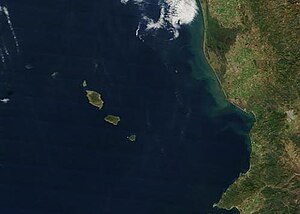Marias Islands
| Marias Islands | ||
|---|---|---|
| NASA image of the Marias Islands off the coast of Mexico | ||
| Waters | Pacific Ocean | |
| Geographical location | 21 ° 32 ′ N , 106 ° 28 ′ W | |
|
|
||
| Number of islands | 4 (plus 5 rocks) | |
| Main island | Maria Madre | |
| Total land area | 244.97 km² | |
| Residents | 1116 (2005) | |
| Location of the Marias Islands | ||
The Marias Islands ( Spanish Islas Marías ) are a group of islands in the Pacific off the west coast of Mexico . They belong to the state of Nayarit and include the Colonia Penal Federal Islas Marías prison . The islands have the status of a Mexican biosphere reserve.
The archipelago is located around 70 kilometers west of the Mexican coast and consists of the following four islands:
- María Madre : area 145.28 km², altitude 616 m
- María Magdalena : area 70.44 km², altitude 457 m
- María Cleofas : area 19.82 km², altitude 402 m
- San Juanito : area 9.11 km²
The name is based on three women from the New Testament of the Bible with the name Maria, namely Maria, the mother of Jesus , Maria Magdalena and Maria Cleophae .
After their discovery in 1532 by Diego Hurtado de Mendoza , a cousin of Hernán Cortés , the islands served as a refuge for pirates for centuries . In the 19th century, a settlement was built on María Madre, from which forestry and the exploitation of the salt mines were carried out. A penal colony has existed on this island since 1905. In contrast, the other islands are uninhabited, large parts are now a nature and biosphere reserve .
In addition to the prisoners in the prison, Maria Madre also houses employees of various government institutions, such as the Secretariat for Public Education , the Secretariat for the Environment, the Secretariat for Communications and Transport , a post office and the Secretariat of the Navy.
Flora and fauna
The Marias Islands are known for their flora and fauna. They are home to eleven endemic plant species as well as several animal species that only occur there, including the Marias raccoon ( Procyon insularis ), the Marias cottontail rabbit ( Sylvilagus graysoni ), the Tres Marias deer vole ( Peromyscus madrensis ) and the mouse-eared species Myotis findleyi .
Web links
- Islas Marías on Oceandots ( Memento from December 23, 2010 in the Internet Archive ) (English)
- The underwater fauna of the Marias Islands (English)
- Declaration of the archipelago as a biosphere reserve (Spanish)
Individual evidence
- Link to tables of residents from the 2005 census, Nayarit INEGI: Instituto Nacional de Estadística, Geografía e Informática
- Mexican islands with areas and coordinates ( Memento from August 17, 2007 in the Internet Archive )


